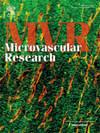Effects of veno-arterial extracorporeal membrane oxygenation on skeletal muscle function and interstitial PO2 in contracting muscle of normal rats
IF 2.7
4区 医学
Q2 PERIPHERAL VASCULAR DISEASE
引用次数: 0
Abstract
Background
This study aimed to clarify the effects of veno-arterial extracorporeal membrane oxygenation (VA-ECMO) on skeletal muscle oxygen pressure and function in rats.
Methods
Male Sprague-Dawley rats (2–3 months old, n = 17) were randomized into control and VA-ECMO groups. All animals were anesthetized and mechanically ventilated. The VA-ECMO circuit was established by cannulating the right jugular vein and left carotid artery. Interstitial PO2 in the tibialis anterior (TA) muscle was measured using a phosphorescence quenching technique during electrically induced muscle contractions. Muscle tension was analyzed to evaluate the rate of force development (RFD) and relaxation rate.
Results
Compared to controls, arterial oxygen pressure (PaO2) was significantly higher, while hemoglobin levels were significantly lower in the VA-ECMO group (both p < 0.01). Interstitial PO2 was significantly reduced at rest and during contractions in the VA-ECMO group (both p < 0.01). Muscle relaxation was delayed, and peak tension was lower in the VA-ECMO group compared to controls (both p < 0.01).
Conclusions
VA-ECMO impairs skeletal muscle function and reduces interstitial PO2 in contracting muscles, effects that appear independent of hyperoxemia. These findings provide insight into the microcirculatory and functional consequences of VA-ECMO on skeletal muscle.
静脉-动脉体外膜氧合对正常大鼠骨骼肌功能及收缩肌间质PO2的影响
本研究旨在阐明静脉-动脉体外膜氧合(VA-ECMO)对大鼠骨骼肌氧压和功能的影响。方法选取2 ~ 3月龄的雄性sd大鼠17只,随机分为对照组和VA-ECMO组。所有动物均麻醉并机械通气。通过右颈静脉和左颈动脉插管建立VA-ECMO回路。在电诱导肌肉收缩时,采用磷光猝灭技术测量胫骨前肌间质PO2。分析肌肉张力,评估力发展率(RFD)和松弛率。结果与对照组相比,VA-ECMO组动脉氧压(PaO2)显著升高,血红蛋白水平显著降低(p <;0.01)。VA-ECMO组间质PO2在静息和收缩时均显著降低(p <;0.01)。与对照组相比,VA-ECMO组肌肉松弛延迟,峰值张力较低(p <;0.01)。结论sva - ecmo损害骨骼肌功能,降低收缩肌间质PO2,其作用与高氧血症无关。这些发现为VA-ECMO对骨骼肌的微循环和功能影响提供了见解。
本文章由计算机程序翻译,如有差异,请以英文原文为准。
求助全文
约1分钟内获得全文
求助全文
来源期刊

Microvascular research
医学-外周血管病
CiteScore
6.00
自引率
3.20%
发文量
158
审稿时长
43 days
期刊介绍:
Microvascular Research is dedicated to the dissemination of fundamental information related to the microvascular field. Full-length articles presenting the results of original research and brief communications are featured.
Research Areas include:
• Angiogenesis
• Biochemistry
• Bioengineering
• Biomathematics
• Biophysics
• Cancer
• Circulatory homeostasis
• Comparative physiology
• Drug delivery
• Neuropharmacology
• Microvascular pathology
• Rheology
• Tissue Engineering.
 求助内容:
求助内容: 应助结果提醒方式:
应助结果提醒方式:


